I have been blessed with a son who is also a wildlife fanatic and through his profession as a geologist has lived in some exciting areas of the world. After Oman and Brunei his career path has taken him to Calgary in Alberta, Canada. You can imagine that I did not have to be asked twice to pay a visit. So in mid-May my wife Beryl and I duly arrived in Calgary on a pleasant day with the temperature in the mid-twenties. Within two days we were to experience the amazing changes in the weather here as a blizzard kept us housebound for the whole day.
Calgary is an ideal base to explore western Alberta. The Rocky Mountains are just an hour's drive to the west, whilst travelling less than that time to the east will find you in flat prairie land, but with some exceptional wetlands. Calgary itself also has some fine urban sites especially along the green corridors of its rivers Bow and Elbow.
I managed regular visits to two such places:
The Inglewood Bird Sanctuary is within sight of downtown Calgary but is a green oasis alongside the Bow River. Easy access to its meadows, woods and ponds provides excellent and easy birding. This is one of the few places in the region where Wood Ducks nest but Common Merganser, Hooded Merganser and Goldeneye are also always present. The large Belted Kingfisher and Great Blue Herons occupy the fringes of open water whilst hundreds of Tree Swallows squabble for nest sites in the cavities of the larger trees, but European Starlings are aggressive competitors. As spring moved on Yellow and Yellow-rumped Warblers chorused in the scrub and stunning Baltimore Orioles were singing their sweet song from the canopy. Northern Flickers and Cedar Waxwings were also obvious in the woods. In more open areas Eastern Kingbirds and Least Flycatchers hunted the woodland edge.

Wood Duck, Canada (Photo: Derek Moore)

Yellow-rumped Warbler, Canada (Photo: Derek Moore)
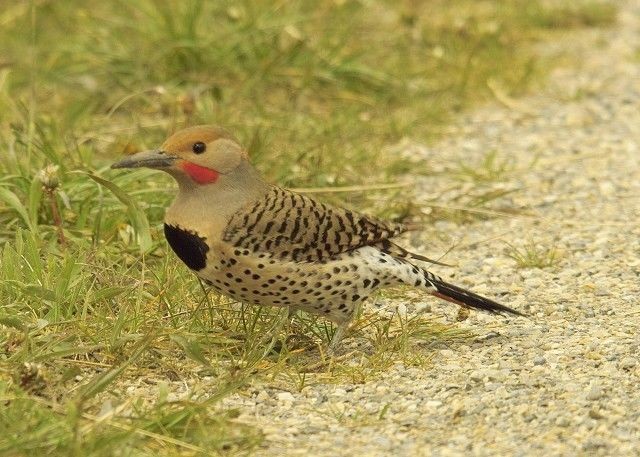
Northern Flicker, Canada (Photo: Derek Moore)
Approaching the river we could pick up groups of gulls on shingle bars and these included Franklin's, Ring-billed and California Gulls. Ospreys are very common all over Canada and here they were fishing daily within the city limits. An afternoon bonus here was a Common Nighthawk that fed in broad daylight for an hour.

Franklin's Gull, Canada (Photo: Derek Moore)

California Gull, Canada (Photo: Derek Moore)
The other urban site was more on the fringes of the city: Glenmore Reservoir with its Weaselhead Trail was a great favourite. The reservoir holds large numbers of wildfowl in spring, of which Blue-winged Teal, Shoveler, Green-winged Teal and American Wigeon are the most numerous of the dabbling ducks. In deeper water Common and Barrow's Goldeneye together with Lesser Scaup are to be found. Large numbers of Canada Geese seem to be more acceptable here, but small numbers of Trumpeter Swans were a real bonus. Just for one morning a pair of Caspian Terns fished close to the parking lot.
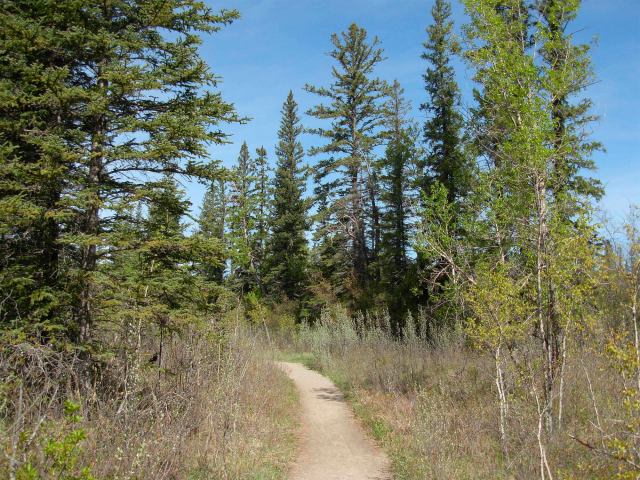
Weaselhead Trail (Photo: Derek Moore)
Getting to Weaselhead you have to cross a bridge underneath which there is a largish colony of Cliff Swallows and nearby nesting Eastern Phoebe. Once on this boreal trail it can get pretty exciting. Rusty Blackbirds squeak from treetops, Yellow-bellied Sapsuckers occupy rotten stumps and Ruffed Grouse thump out their display from fallen logs. Alder Flycatchers and if you are lucky Lazuli Buntings frequent the scrubby clearings. The highlight here though is Calliope Hummingbird, which buzzes around clearings even with snow still on the ground.

Yellow-bellied Sapsucker, Canada (Photo: Derek Moore)
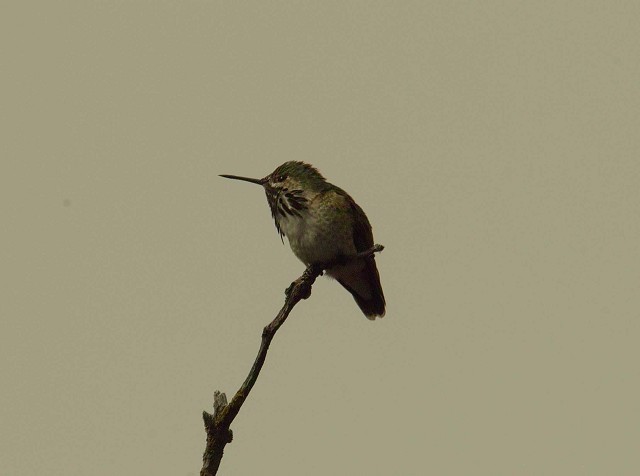
Calliope Hummingbird, Canada (Photo: Derek Moore)
The closest access to the Rocky Mountains is Canmore and my preferred option is to approach the town via Kananaskis and then the gravel road past Spray Lakes. This is stunning country and even the metalled road can attract large mammals. Elk are a regular feature and at points where rocky cliffs meet the road then Bighorn Sheep descend to lick the salt off the road surface. Birds noted here include Harlequin, Boreal Chickadee, American Redstart and American Three-toed Woodpecker.

Canmore (Photo: Derek Moore)

Bighorn Sheep (Photo: Derek Moore)
Moving on to the gravel road raises the adrenalin considerably. Birds are difficult to find but a real bonus when you succeed. Lakes by the roadside have a few pairs of Common Loons and you note the occasional Bald Eagle. Barrow's Goldeneyes are again regular but finding passerines can be an effort. Imagine my joy at finding a superb male Pine Grosbeak sitting in the middle of the road. Chipping Sparrows and the Oregon form of Dark-eyed Juncos are common but catching sight of a Varied Thrush was real challenge. Scrambling around the woods here has its hazards: Grizzly Bears and Cougars are present so a little care is needed.

Bald Eagle, Canada (Photo: Derek Moore)

Pine Grosbeak, Canada (Photo: Derek Moore)

Lake in the Rocky Mountains (Photo: Derek Moore)
Townsend's Warbler, Pine Siskin and White-crowned Sparrow were relatively easy but woodpeckers were frustrating: lots of drumming but few sightings. The enormous Pileated Woodpecker, as well Downy and Hairy Woodpeckers, were located as were hordes of Red-breasted Nuthatches. Gangs of curious Gray Jays appeared at every corner.

Red-breasted Nuthatch, Canada (Photo: Derek Moore)
This road is also excellent for seeing mammals and White-tailed and Mule Deer were regular grazing on the roadsides. Moose would also occasionally cross the road, often in a leisurely fashion. Columbian Ground Squirrels and Least Chipmunks are particularly numerous here too and obviously are an important prey item for the carnivores and raptors here.

Mule Deer (Photo: Derek Moore)

Moose (Photo: Derek Moore)
From Canmore, where this is lots of accommodation, you can enter the Banff National Park and thereafter drive right up to Jasper. When we did this in late May it was still incredibly cold and the lakes and rivers frozen and the land covered in snow. The main bird interest, though, was at parking lots. Here gangs of Brown-headed Cowbirds, Ravens, Gray and Steller's Jays came begging for food, but the stars were the numerous Clark's Nutcrackers who showed no fear and even perched on car wing mirrors.

Clark's Nutcracker, Canada (Photo: Derek Moore)
We did venture as far north as the Athabasca Glacier but promises of White-tailed Ptarmigan did not materialize. We were rewarded though by several Black Bears which were emerging from hibernation and fattening up on dandelions by the roadside. There was more! Heading back to our lodge on a back road we were amazed to come across a Timber Wolf trotting down the road and which moved onto a clearing and posed for fifteen minutes for its picture to be taken. Eventually it sloped off into the forest.

Black Bear (Photo: Derek Moore)

Timber Wolf (Photo: Derek Moore)
On another day we visited the Sheep River Valley in the foothills. This was a more gentle landscape with rolling grasslands, deep gorges and large forests. En route we drove through farmland with lots of meadows and were delighted to see Mountain Bluebirds perching on fence posts along most of the way. Entering the forests we encountered Warbling Vireos, Least Flycatchers and lots more Red-breasted Nuthatches. The more open areas were more productive and here we located Townsend's Solitaire, American Kestrel, Red-tailed Hawk and Golden Eagle.

Mountain Bluebird, Canada (Photo: Derek Moore)
Time spent down by the river was also fruitful with great views of American Dipper, Spotted Sandpiper and Harlequin. The final event of the day was a fantastic male Northern Goshawk flying past at very close quarters.

American Dipper, Canada (Photo: Derek Moore)
To the south and east of Calgary the terrain is so different: a vast flat area of prairie where cattle ranching and arable farming are dominant. The plus for wildlife is the honeycomb of lakes, ponds and flashes interspersed with the agricultural activity.

Prairies (Photo: Derek Moore)
My first visit was to a quite small area known as Sadler's Slough. It was really just a dirt track surrounded on both sides with a habitat of wet grassland, shallow ponds and reeds. On arrival you soon realize that Yellow-headed and Red-winged Blackbirds dominate these areas. Their almost electronic songs deafen you whilst looking for other species. A great surprise was finding a pair of Slavonian Grebes nesting by the side of the track in habitat quite unlike the areas you find this bird in Scotland.

Yellow-headed Blackbird, Canada (Photo: Derek Moore)
Wildfowl and waders were very obvious and I found my lifer Cinnamon Teal along with Northern Pintail, American Wigeon and Blue-winged Teal. A deeper pond revealed Lesser Scaup, Canvasback and Redhead. American Avocets and Black-necked Stilts were easy but more effort was needed to add Long-billed Dowitcher, Willet, Wilson's Snipe, Least Sandpiper and Marbled Godwit. After even more staring into the long grass my first Sprague's Pipit materialized. Very obvious too were our first small flocks of Wilson's Phalaropes.

Willet, Canada (Photo: Derek Moore)

Wilson's Snipe, Canada (Photo: Derek Moore)

Wilson's Phalarope, Canada (Photo: Derek Moore)
The best wetland area was just an hour's drive south of Calgary at a very impressive site called Frank Lake. This very large area of shallow water and meadows is owned by the Duck Stamp Association, which is ostensibly the equivalent of the British Association of Shooting and Conservation: yes, a wildfowling organization. Our visit coincided with their open day for sponsors. Even so we were warmly welcomed and allowed the run of the extensive visiting facilities.
The first thing that strikes you is the large number of Richardson's Ground Squirrels, which in turn attracts a large number of Swainson's Hawks. In fact this hawk is the commonest raptor in the prairies and around Calgary.

Richardson's Ground Squirrel (Photo: Derek Moore)
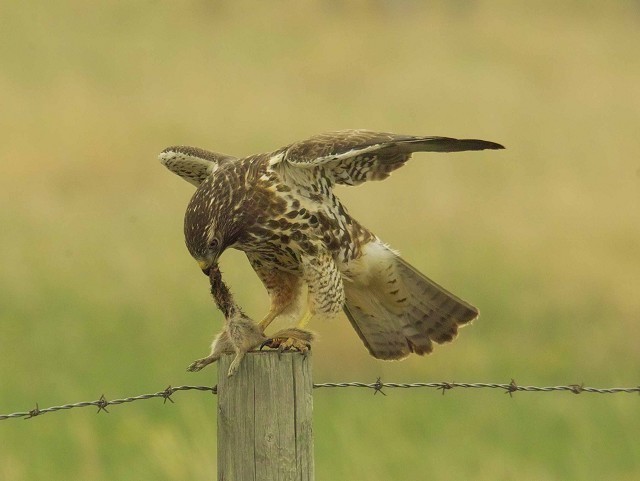
Swainson's Hawk, Canada (Photo: Derek Moore)
From a comfortable hide I was fazed by huge rafts of thousands of Black-necked Grebes, some already paired and nest building. Ruddy Ducks bubbled nearby and careful scoping soon located my first Western Grebes. Dozens of White-faced Ibis flew backwards and forwards to their nest sites and the air was full of thousands of nesting Franklin's Gulls. Forster's and Black Terns added to the cacophony and American White Pelicans fished out on the deeper water. In similar areas flocks of Lesser Scaup and Redheads were joined by smaller numbers of Buffleheads. Evening saw large roosts of California and Ring-billed Gulls and also Double-crested Cormorants.

Frank Lake hide (Photo: Derek Moore)
I could hear Sora Rails calling everywhere and after a wait managed to mimic the call enough to tease one out into the open for a couple of photographs. Waders were easy to find in the muddier areas and included a splendid group of Grey Plovers in breeding plumage. Willet, Marbled Godwits, American Avocets and Black-winged Stilts were again everywhere as well as noisy Killdeers nesting in the grassy areas.

Sora, Canada (Photo: Derek Moore)
If I thought I had enjoyed a phalarope experience before, how wrong I was. It seemed like they were everywhere as flock after flock of Wilson's Phalaropes flew in to feed or moved off in flocks of hundreds seeking breeding grounds further north. It really put into perspective the first for Suffolk that I saw at Minsmere in June 1971.
Driving around the fringes of the lake revealed more birds, particularly in the grassy areas: more Sprague's Pipits and good numbers of Savannah Sparrows, Clay-coloured Sparrows, Vesper Sparrows, Horned Larks and Western Meadowlarks. Learning the song was important to find the much sought-after Baird's Sparrow and luck was with me in finding Chestnut-collared Longspur. A stubble field also produced the only sighting of Long-billed Curlew.
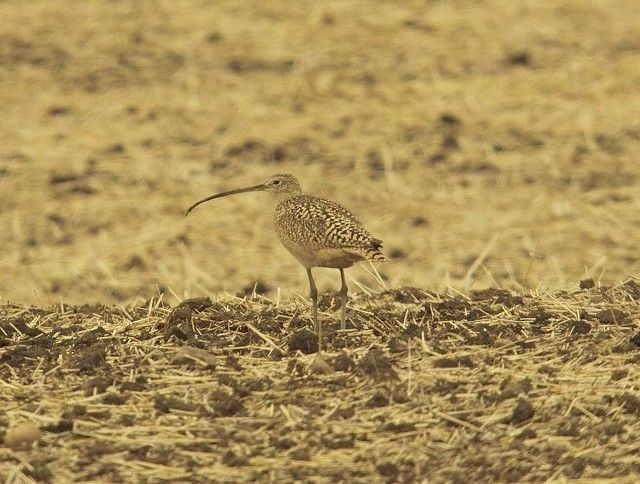
Long-billed Curlew, Canada (Photo: Derek Moore)
MacGregor Lake was a bit more distant and a visit here found similar species to Frank Lake. There were far more Cinnamon Teal though and small numbers of Ring-billed Gulls. American White Pelicans were more numerous here too.
These wetlands are fantastic and I wished I could spend longer in this area to watch migration throughout the year. In winter, of course, large numbers of Snow Geese arrive and Snowy Owls and Gyrfalcons hunt these areas.
Alberta was a great experience and I cannot wait to return (if invited). The Rocky Mountains are well known but the prairie wetlands perhaps less so. I am also fortunate to have a son and grandson who share my enthusiasm to get out birding. The area is easy to visit with direct flights from Gatwick to Calgary. Why not give it a go?

